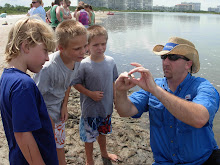 |
| A male sheepshead minnow |
Sheepshed minnows have relative deep bodies, are silver to olive-gray in color, and have irregular dark bands the extend over most of their sides. Males and females can be distinguished from one another as well; the edge of the male's caudal fin is darkened and females have an oscillated spot on their dorsal fin.
Sheepshead minnows are found along the Atlantic coast throughout the Gulf of Mexico and south along the South American coastline. They are hardy fish and can tolerate a wide range of salinities. They inhabit quiet shallow waters associated with bays, lagoon, marshes, and tidal creeks. In fact, they can also survive in low-to- no oxygen waters by gulping air at the water's surface. Often they are found in schools. Sheepshead minnows are opportunistic feeders. They will feed on plant material, algae, detritus, mosquitoes and smaller fish. They also serve as an important food source for several wading birds as well as many larger fish such as red drum, snook, and spotted sea trout.
Sheepshead minnows are fast growing, short-lived fish. They can reach sexual maturity at three months old, and may only live two or three years (their exact life expectancy is unknown). During breeding the males display iridescent sky blue patches on top of their backs and orange blotches on their bellies. The females, which are smaller bodied than the males can display similar, but muted colors. The males construct nest pits in bay bottoms to attract females, and will fiercely defend their nests. Females can spawn several times during the spawning season and deposit several hundred eggs per spawning period. Hatching typically occurs during spring and summer.
 |
| A sheepshed minnow in breeding colors |
References:




No comments:
Post a Comment